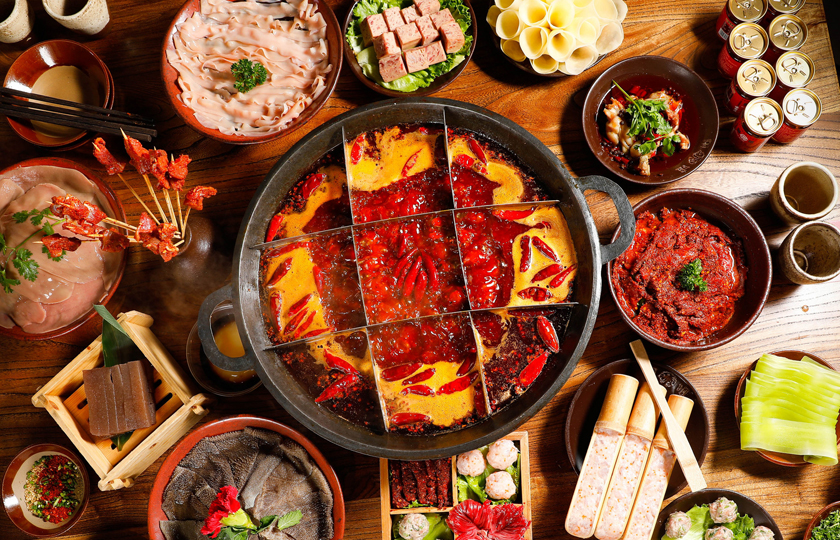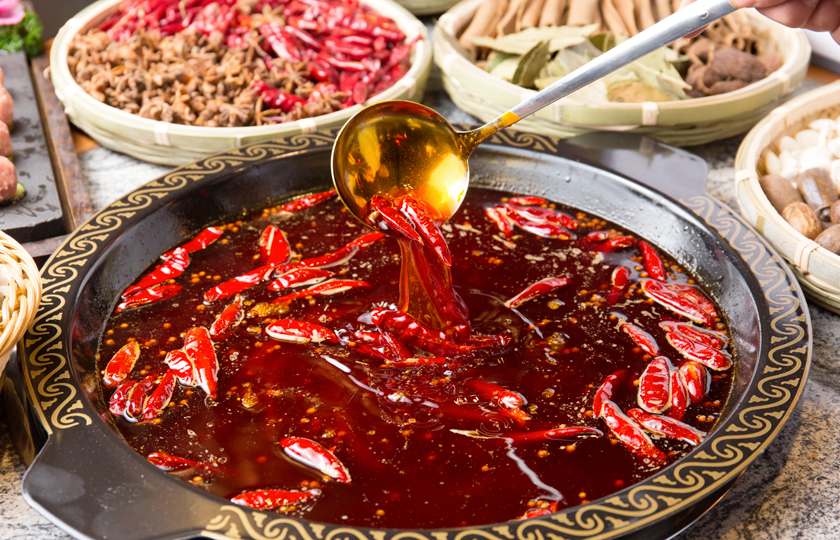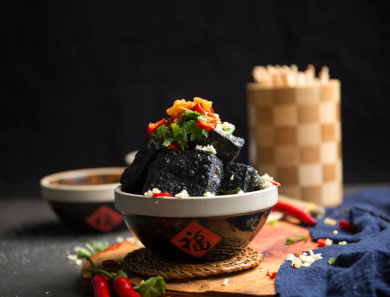The Cultural Heritage Behind the Spice: Why Is Chongqing Food So Spicy?

I've always considered myself someone who can handle spicy food without even batting an eye. That was until I visited Chongqing, which completely redefined my understanding of spice.
Why Chongqing Cuisine is So Spicy
Chongqing cuisine is renowned for its intense spiciness, and there are several reasons behind this fiery characteristic.
Climate Influence
First and foremost, Chongqing's climate plays a significant role in shaping its culinary preferences. The region is known for its humid and muggy weather, which can cause the body to retain moisture. Chili peppers are known for their ability to dispel dampness and cold, a discovery made by Chongqing residents through years of living in such conditions. As a result, chili peppers became a staple in Chongqing cuisine, serving as a natural remedy to combat the humid climate. This has led to the pervasive use of strong, spicy flavors in their dishes.
Historical Context
Historically, Chongqing has been a crucial transportation hub and commercial center in Southwest China. The city's strategic location attracted people from various regions, leading to a melting pot of cultures. During this cultural exchange, chili peppers, with their stimulating taste, gained widespread popularity and gradually became a core element of Chongqing's culinary identity. They not only satisfied the locals' craving for bold flavors after a hard day's work but also helped stimulate appetite and restore energy in challenging environments.
Cultural Significance
Culturally, Chongqing boasts a unique and vibrant regional identity. The locals are known for their warm hospitality, straightforwardness, and exuberance. This personality trait is reflected in their preference for strong flavors. The spiciness of Chongqing cuisine symbolizes the fiery and direct nature of its people. The bold and spicy dishes showcase the cultural charm of Chongqing and the spirited character of its residents.
Abundant Local Resources
Additionally, Chongqing is blessed with an abundance of high-quality chili peppers, providing a solid foundation for the spicy flavors in its cuisine. Skilled chefs in Chongqing have mastered the art of incorporating chili peppers into a wide variety of dishes, creating a rich and distinctive spicy profile that sets Chongqing cuisine apart.
In summary, the spiciness of Chongqing cuisine is a result of the region's humid climate, historical cultural exchanges, the spirited nature of its people, and the availability of excellent local chili peppers. These factors combined have given rise to the unique and celebrated spicy flavors that define Chongqing's culinary tradition.
How spicy is Chongqing hotpot?
Chongqing hot pot is renowned for its spiciness, but it's not just about sheer heat. The spiciness is multi-layered and complex, offering a rich and lingering taste experience. From mild to extreme, each level of spiciness has its unique charm and challenge.
Mild Spicy
For those who aren't accustomed to spicy food, even the mild version of Chongqing hot pot can be quite a challenge. However, don't worry—this level of spiciness is primarily meant to enhance the flavor and aroma of the dish. It allows you to savor the hot pot while still experiencing the warmth and hospitality that Chongqing is famous for.
Medium Spicy
When you step up to medium spicy, you need to be prepared. At this level, you can clearly feel the heat and stimulation of the chili peppers, but it's still manageable. For those who can handle a bit of spice, medium spicy is a great choice. It satisfies the craving for heat without being overwhelming.
Extra Spicy
Extra spicy is where things get serious. This level is for the true spice enthusiasts. The heat goes beyond just stimulating your taste buds—it becomes a challenge and a conquest. Each bite delivers an intense burst of spiciness, as if the chili peppers are dancing wildly in your mouth, offering an unparalleled spicy thrill.
Insanely Spicy
And then there's insanely spicy… This level is both loved and feared. It exceeds the tolerance of most people, but there are always brave souls willing to take on the challenge. Some Chongqing hot pot restaurants use specially sourced ultra-hot chili peppers to create this level of spiciness, making it feel like a fire has been ignited on your tongue!
That said, the spiciness of Chongqing hot pot isn't uniform. Each restaurant and chef has their own unique recipes and methods of preparation. So, even if you order the same level of spiciness—whether it's extra spicy or insanely spicy—the flavor and intensity can vary from one hot pot place to another.
In summary, Chongqing hot pot offers a spectrum of spiciness that caters to different preferences and tolerances, each providing a unique and memorable culinary adventure.

What is the difference between Sichuan and Chongging hotpot?
Both Sichuan and Chongqing hot pots are famous for their spicy flavors, but there are some subtle differences between them.
Broth Base Differences
Chongqing Hot Pot: This hot pot favors beef tallow as the base, offering a rich and intense flavor that matches the bold taste preferences of Chongqing locals. The broth is aromatic, often infused with ginger, Sichuan peppercorns, and star anise.
Sichuan Hot Pot: Sichuan hot pot typically uses vegetable oil, focusing on a spicy and numbing sensation. The broth is loaded with chilies and Sichuan peppercorns and can be adjusted based on the season or personal taste, making it more versatile.
Sauces and Dips
Chongqing Hot Pot: The dipping sauces are traditional and straightforward, like sesame oil and garlic, which enhance the spicy flavor without overpowering it.
Sichuan Hot Pot: Offers a wider variety of sauces, including sesame, chili, peanuts, and even seafood options. Diners can mix and match to create a personalized flavor experience.
Ingredient Choices
Chongqing Hot Pot: Focuses on meats like tripe, pig blood, and duck intestines. These ingredients become especially flavorful when cooked in beef tallow. Vegetables are used but less prominently.
Sichuan Hot Pot: Features a balanced mix of meats and vegetables, including seafood, tofu, and a variety of greens, offering diverse textures and flavors.
Names and Style
Chongqing Hot Pot: Restaurant names are often simple and catchy, like “Huang Jie” or “Si Mei,” giving a sense of familiarity. The style is bold and hearty, perfect for those who enjoy a robust dining experience.
Sichuan Hot Pot: Names tend to be more refined, like “Da Long Yan,” reflecting a cultural sophistication. The style is more nuanced, focusing on balanced flavors and ingredient harmony.
In summary, while both hot pot styles are known for their spiciness, Chongqing hot pot is richer and more intense, while Sichuan hot pot is versatile and balanced, offering a broader range of flavors and ingredients.
Is there non-spicy food in Chongqing?
Absolutely! While Chongqing is famous for its fiery hot pot and spicy noodles, there's a whole array of delicious non-spicy foods that are definitely worth trying.
Sour Radish and Duck Soup: This is a refreshing and soothing dish. The sour radish's heat is mellowed by the slow-cooked broth, leaving a tangy and savory flavor that's perfect for those who prefer milder dishes.
Three Delicacies Rice Noodles: Not only is this dish non-spicy, but the broth is incredibly flavorful. It includes ingredients like ham, pork liver, and tomatoes, creating a rich and satisfying taste.
Braised Meats: These meats are tender and flavorful, with a sweet and savory profile. From braised chicken feet to beef and tofu, there's a wide variety of options that are delicious and not spicy.
Chicken Soup Wontons: These wontons have thin skins and generous fillings, making them smooth and chewy. Paired with savory chicken broth, they are a delightful and comforting dish. For a non-spicy option, you can choose the clear broth version.
Mountain City Small Glutinous Rice Balls: A sweet treat that’s a staple in Chongqing! These small, delicate rice balls are filled with sweet fillings and have a soft, chewy texture, perfect as a dessert or afternoon snack.
Ice Jelly: Perfect for hot summer days, this dessert is cool and refreshing. Made from "ice powder seeds" to create a jelly-like consistency, it's typically served with brown sugar syrup, crushed peanuts, and raisins, making it a delightful summer treat.
In addition to these, there are other non-spicy snacks like iron griddle cakes, original fermented rice, traditional oil tea, fried chicken legs, and glutinous rice ice cream. So, even if you're not a fan of spicy food, you can still enjoy a feast in Chongqing!

What is the spicy food in Chongqing?
Chongqing is renowned for its spicy cuisine that leaves a lasting impression. Here are some must-try spicy dishes:
Chongqing Hot Pot
When it comes to Chongqing, hot pot is a must-mention. Known for its numbing and spicy flavors, Chongqing hot pot features a bubbling pot of red oil, rich in spicy and aromatic ingredients. The variety of ingredients, from tripe and duck intestines to various vegetables, all acquire a unique flavor when cooked in the hot pot.
Chongqing Noodles (Xiaomian)
Chongqing noodles are a popular breakfast choice and a highly recommended dish. The noodles are chewy, and the broth is intensely spicy. Combined with seasonal vegetables, the dish offers a rich and satisfying taste. The preparation of Chongqing noodles is meticulous, ensuring the perfect balance of flavors in both the noodles and the broth.
Red Oil Wontons (Hongyou Chaoshou)
Red oil wontons are a signature Chongqing snack. The wontons have thin skins and tender fillings, served with a spicy red oil sauce that is both numbing and flavorful. This dish is not only unique in taste but also crafted with precision, reflecting the Chongqing people's passion for food.
Hot and Sour Rice Noodles (Suanlafen)
Hot and sour rice noodles are a staple Chongqing snack, made from sweet potato noodles in a tangy and spicy broth. The dish is refreshing and appetizing, perfect for summer. The preparation is also meticulous, from ingredient selection to seasoning, ensuring a delightful experience.
Spicy Duck Blood Curd (Maoxuewang)
Maoxuewang is a traditional Chongqing dish featuring duck blood curd and tripe in a spicy and flavorful broth. The dish is rich and memorable, representing the essence of Chongqing's spicy cuisine. The preparation involves multiple steps to achieve the best taste.
Qianjiang Chicken Giblets (Qianjiang Jizha)
Qianjiang chicken giblets are a specialty from Chongqing's Qianjiang district. The dish features chicken giblets cooked with chilies and Sichuan peppercorns, offering a tangy, spicy, and savory flavor. The unique blend of seasonings and cooking techniques results in a dish with rich and layered flavors.
Spring Water Chicken (Quanshui Ji)
Spring water chicken is a new favorite in the Sichuan-Chongqing region. The dish features chicken cooked with chilies and Sichuan peppercorns in spring water. It is aromatic, spicy, and flavorful, beloved by many. The preparation emphasizes ingredient quality and cooking techniques, ensuring a fresh and nutritious meal.
Chongqing Spicy Chicken (Chongqing Laziji)
Chongqing spicy chicken is a classic local dish, featuring chicken pieces cooked with a generous amount of dried chilies and Sichuan peppercorns. The dish is visually appealing with its red hue and offers a crispy, spicy, and aromatic taste. The cooking process requires precise control of heat and seasoning to achieve its distinctive flavor.
In addition to these dishes, Chongqing offers other spicy delights like Wu's Wontons and Skewered Snacks (Chuan Chuan Xiang). These dishes vary in spice levels, catering to different preferences and providing a rich and diverse culinary experience.
What spice numbs your tongue?
Several spices can cause a numbing sensation on the tongue, each with its unique characteristics and culinary applications. Here are some of the most notable ones:
Sichuan Peppercorn
Characteristics: Sichuan peppercorn is the most well-known numbing spice, available in various types like the Da Hong Pao variety, which has large, red-hued grains. The numbing sensation is due to the presence of hydroxy-alpha-sanshool. When chewed, the numbing effect spreads like an electric current from the tip of the tongue throughout the mouth.
Application: Widely used in Sichuan cuisine, classic dishes like "Shuizhu Yu" (水煮鱼) feature a generous amount of Sichuan peppercorns. When heated in oil, they release a unique numbing aroma, infusing the fish and vegetables with a distinctive numbing flavor.
Green Sichuan Peppercorn
Characteristics: Similar in appearance to regular Sichuan peppercorns but with a fresher, herbal aroma. The numbing sensation is more gentle and spreads slowly across the tongue, akin to a breeze carrying a hint of numbing flavor.
Application: In dishes like "Tengjiao Ji", the oil infused with green Sichuan peppercorns permeates the chicken, making it tender and juicy with a refreshing numbing taste.
Green Peppercorn
Characteristics: Bright green with plump fruits, this peppercorn has a fresh scent and a strong numbing effect due to its high content of volatile oils and alkaloids. The numbing sensation is immediate and sharp, like a lightning strike on the tongue.
Application: A key ingredient in dishes like "Qingjiao Yu" (青椒鱼), where it combines with green chilies to create a powerful interplay of numbing and spicy flavors, enhancing the freshness of the fish.
Mala Pepper
Characteristics: Similar in appearance to Sichuan peppercorns but with a more intense and penetrating numbing effect. Its unique composition results in a long-lasting, strong numbing sensation.
Application: In "Mala Ji", the mala pepper blends perfectly with the chicken, offering a numbing sensation like a tidal wave, contrasting with the tender chicken for an extreme sensory experience.
Mountain Pepper
Characteristics: Small, black or green fruits with a numbing effect similar to Sichuan peppercorns but with a unique flavor profile. It contains citronellal and geraniol, which provide a numbing sensation along with a distinctive aroma.
Application: Common in ethnic and regional dishes like Guizhou's "Suantang Yu" (酸汤鱼), where the numbing and aromatic qualities of mountain pepper add a novel and stimulating taste experience.
Long Pepper
Characteristics: Cylindrical with small diagonal protrusions, long pepper has a mild and nuanced numbing effect that releases slowly during cooking.
Application: Found in Indian and Southeast Asian cuisines, such as Indian curry lamb dishes, where it blends with other spices to infuse the meat and curry sauce with a subtle numbing aroma, adding an exotic twist.
Capers
Characteristics: Grown in arid regions, caper fruits are used as a spice with a wild, numbing flavor due to various active compounds.
Application: In Mediterranean cuisine, capers are used in salads and roasted meats. For example, roasted lamb with capers gains a unique numbing flavor that complements the meat, creating a delightful taste combination.
Prickly Ash
Characteristics: A perennial herb with a mild numbing effect and a fresh, herbal aroma.
Application: Used in medicinal and traditional nourishing dishes, such as chicken soup with medicinal herbs, where the numbing flavor subtly infuses the broth, blending with other flavors for a warm and unique experience.
These spices, each with its distinct numbing sensation and flavor profile, play crucial roles in various culinary traditions, adding depth and complexity to dishes across different cuisines.























